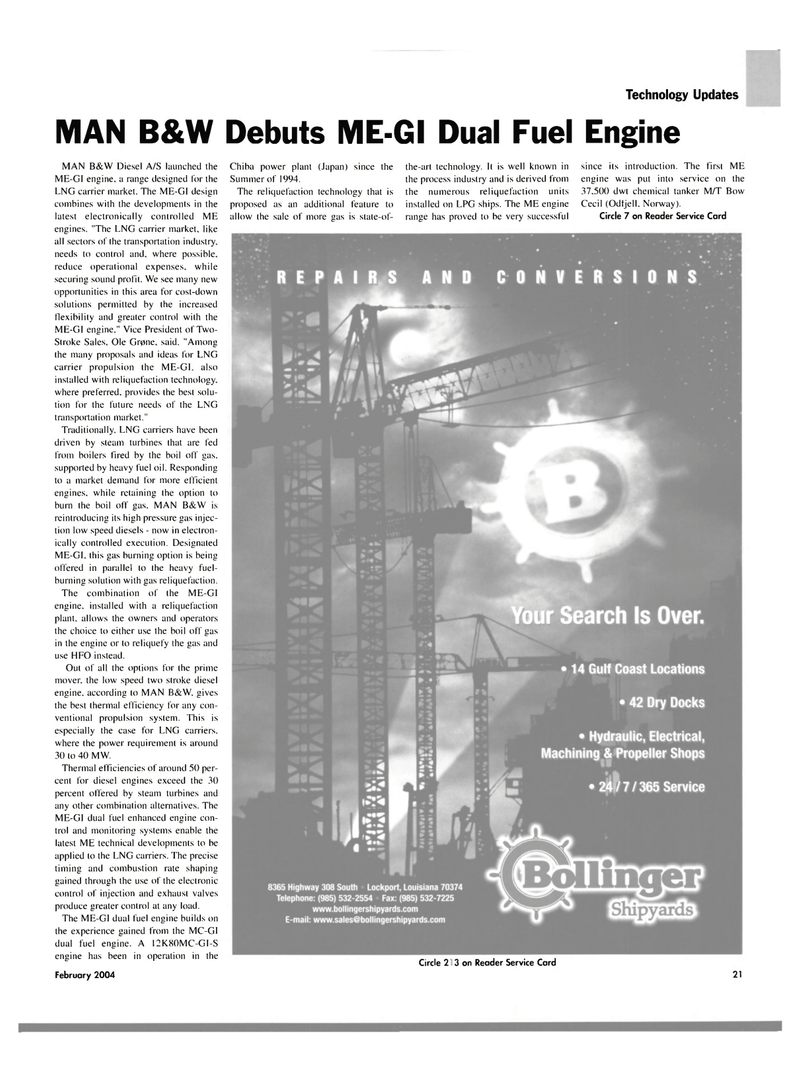
Page 24: of Maritime Reporter Magazine (February 2004)
The Tanker Yearbook: ATB Edition
Read this page in Pdf, Flash or Html5 edition of February 2004 Maritime Reporter Magazine
Technology Updates
MAN B&W Debuts ME-GI Dual Fuel Engine
MAN B&W Diesel A/S launched the
ME-GI engine, a range designed for the
LNG carrier market. The ME-GI design combines with the developments in the latest electronically controlled ME engines. "The LNG carrier market, like all sectors of the transportation industry, needs to control and. where possible, reduce operational expenses, while securing sound profit. We see many new opportunities in this area for cost-down solutions permitted by the increased flexibility and greater control with the
ME-GI engine," Vice President of Two-
Stroke Sales, Ole Gr0ne, said. "Among the many proposals and ideas for LNG carrier propulsion the ME-GI. also installed with reliquefaction technology, where preferred, provides the best solu- tion for the future needs of the LNG transportation market."
Traditionally. LNG carriers have been driven by steam turbines that are fed from boilers fired by the boil off gas. supported by heavy fuel oil. Responding to a market demand for more efficient engines, while retaining the option to burn the boil off gas. MAN B&W is reintroducing its high pressure gas injec- tion low speed diesels - now in electron- ically controlled execution. Designated
ME-GI. this gas burning option is being offered in parallel to the heavy fuel- burning solution with gas reliquefaction.
The combination of the ME-GI engine, installed with a reliquefaction plant, allows the owners and operators the choice to either use the boil off gas in the engine or to reliquefy the gas and use HFO instead.
Out of all the options for the prime mover, the low speed two stroke diesel engine, according to MAN B&W. gives the best thermal efficiency for any con- ventional propulsion system. This is especially the case for LNG carriers, where the power requirement is around 30 to 40 MW.
Thermal efficiencies of around 50 per- cent for diesel engines exceed the 30 percent offered by steam turbines and any other combination alternatives. The
ME-GI dual fuel enhanced engine con- trol and monitoring systems enable the latest ME technical developments to be applied to the LNG carriers. The precise timing and combustion rate shaping gained through the use of the electronic control of injection and exhaust valves produce greater control at any load.
The ME-GI dual fuel engine builds on the experience gained from the MC-GI dual fuel engine. A 12K80MC-GI-S engine has been in operation in the
February 2004
Chiba power plant (Japan) since the
Summer of 1994.
The reliquefaction technology that is proposed as an additional feature to allow the sale of more gas is state-of- the-art technology. It is well known in the process industry and is derived from the numerous reliquefaction units installed on LPG ships. The ME engine range has proved to be very successful since its introduction. The first ME engine was put into service on the 37.500 dwt chemical tanker M/T Bow
Cecil (Odtjell. Norway).
Circle 7 on Reader Service Card
Circle 236 on Reader Service Card 21

 23
23

 25
25
